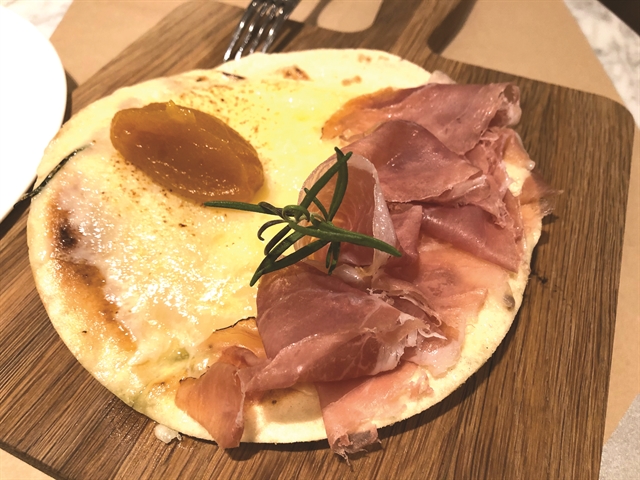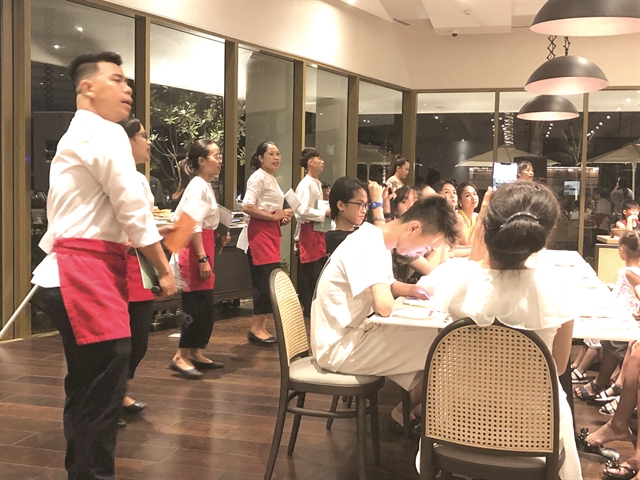 Restaurant Review
Restaurant Review

Italian restaurant La Casa highlights not only traditions in Italian food but also the Italian attitude towards life, which is best described as La Dolce Vita.
by Nguyễn Mỹ Hà
Located along a beautiful stretch of seashore at Bãi Dài, or Long Beach, in Cam Ranh Bay, the new Alma resort makes you feel as though you’ve stumbled into a little piece of paradise.
New but with green foliage yet to cover all of the property, the atmosphere created by the staff gives you a sense that you’re the most important visitor to ever pass through the front gates.
The resort sits on 30 ha by the beach, which is as big as a village, and has five restaurants representing different food styles: Italian, Japanese, a food court, a seafood house, and Alma garden for continental breakfast. It’s like a mini UN, where all countries co-exist in peace, even though not every culture or culinary tradition could possibly be represented.
In that spirit, the resort’s Italian restaurant La Casa highlights not only traditions in Italian food but also the Italian attitude towards life, which is best described as La Dolce Vita.
Translated as “The Sweet Life” and the name of a classic Italian film from Federico Fellini that won both the Palme D’Or and an Oscar in 1960, La Dolce Vita was indeed what we found at La Casa.
The spacious restaurant serves fine food in a cosy ambience resembling an Italian home. The tableware is neither too dull for trendsetters nor too offbeat for lovers of tradition.
One of the great Italian treats is anti-pasti, or appetisers. The tiny pieces of gourmet food wake up your taste buds and prepare you for the meal that follows. We chose Culatello and Provolone (VNĐ230,000), which has culatello ham, grilled Tomino cheese, and onion jam on rosemary bread, as well as a cheese and cold cuts platter (VNĐ495,000).
The meat was great and the cheese had everyone talking.

|
| BEST OF ANTI-PASTI: Culatello and Provolone and onion ham. |
We visited La Casa on a Friday evening, when we had heard there would be live singing.
The songs are an initiative of the resort’s general manager, Herbert Laubichler-Pichler, who as an art aficionado was the driving force behind the art-in-residence program at the resort he previously worked at. Now he has his young wait staff sing happy songs as guests enjoy their dinner. I liked the idea, as I’d heard O Sole Mio or Torna a Surriento a few times in other Italian restaurants. But they were sung by actual singers, not the wait staff. It occurred to me that this makes their job a lot busier.
So I had my doubts until the songs began and their voices filled the air.
For our main courses we had ordered spaghetti Bolognese (VNĐ240,000) with parmesan cheese, grilled jumbo prawns (VNĐ370,000) with a Mediterranean sauce, tomatoes, capers, olives, and basil, and an aged beef fillet steak of 200 grams (VNĐ660,000) with truffle and mashed potatoes and porcini mushrooms.
There was a little gap between the dishes arriving as the wait staff presented diners with the lyrics. Their fresh young faces first encouraged everyone to clap when they started singing and then to hum along. Many visitors ended up on their feet as the songs rang out.
It was such a joyous scene, more like being at a wedding than a restaurant.
“Hey honey, come with me to this deserted sandy beach,
We’ll live sunny summer days under the inviting shade of coconut trees,
I’ll tell you that I’ll love you forever, as these words I’ve been holding back so dearly!”
The lyrics and melodies of popular Vietnamese songs were also a perfect reflection of La Dolce Vita, a movie loved by so many but also denounced by the church for the reckless lifestyles it portrays.
La Dolce Vita also left an imprint on journalism, because it gave birth to the term “paparazzo”, which became “paparazzi” in English and is defined in the Oxford dictionary as meaning “a photographer who follows famous people around to shoot photos of them to sell to newspapers”. Always used in the plural, the word may have originated from Italian but is today universal.

|
| CUT UP: The beef was so good it simply had to be shared. VNS Photos Mỹ Hà |
Made in the 1960s, when Italian fashion was booming, the film’s female characters wore the latest stunning creations.
The life of paparazzi may evolve around café society, famous people, and reckless lifestyles, but it also pulls photojournalists between the more cultured lives of intellectuals and those with more materialistic tendencies, which the church was so keen to denounce.
The Alma opened its doors soon after the first wave of COVID-19 in the country subsided. It was already a popular destination for many from HCM City and even Hà Nội, who would fly in their extended family of 20 or sometimes even 30 people.
On that Friday night, all of the guests sat down after the songs had finished and the wait staff got back to their “normal” work. And our mains soon arrived -- all of which we enjoyed in peace.

|
| SONGS OF JOY: The bright faces and dulcet tones of the young wait staff at La Casa lit up the evening. |
It was starting to get a little late when our dessert came. Panna Cotta (VNĐ120,000) with vanilla panna cotta and raspberry pistachio sauce. I’m not normally a fan of panna cotta, because it’s a little too soft, sweet, and boring for my taste. But the raspberry pistachio sauce made me think again. It was so delicious and sophisticated, with just the level of sweetness one needs in this time of turbulence.
La Casa was full that evening, and with people singing and moving around joyously it was indeed the sweet life many of us crave, at least for a few days a year with our families. So, put on your summer best and take yourself to the Alma and its La Casa restaurant. VNS




